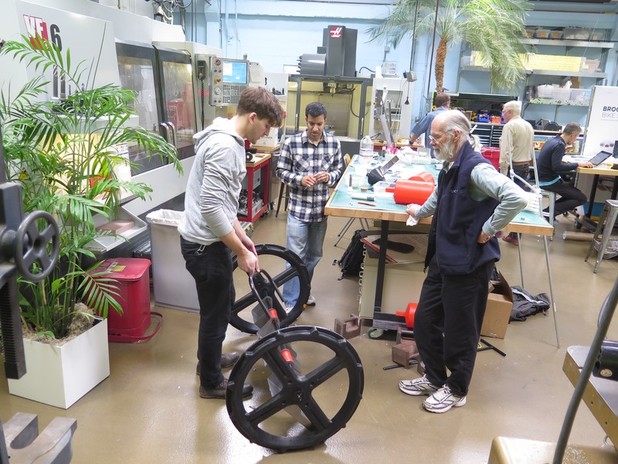March 21, 2014
The Teff Mudders set to work building a fully functional prototype of their teff row planter before heading back to Ethiopia for field testing.
After a long interim of meetings and Post-It notes, it was time to set up camp in the shop and start building our planter. It’s a daunting task to build an entire machine from scratch in just a few weeks, so we knew we had to be strategic about making decisions very quickly.
Our first big task was to create a metering system for teff–not a small undertaking considering one had yet to be created successfully by the industry as a whole. They had been built for other crops with much larger seeds, but when it came to our tiny teff, seeds just got crushed like in a peppermill.
We decided on a design principle: hard on soft. By using soft elements in the metering mechanism, we could compensate for loose tolerances and handle seeds more carefully. We experimented with brushes to transport the seeds. Some brushes from hardware stores (and maybe one or two “borrowed” from our girlfriends) until we found what worked best. The results were promising so eventually we had custom brushes made for our planter.
In the meantime, our mechanical engineer, Remy Pieron–the newest addition to the Teff Mudders team–was hard at work understanding what our planter’s wheels might look like. We had ordered a rice drum seeder from the Philippines to draw inspiration from and adapt for our prototype.
Within days, Remy had built a working prototype of wheels including a ratchet, a simple mechanism that allowed us to switch the metering mechanism on and off very easily. This was important so farmers can roll the planter to and from the field without dispensing seeds. Once at the field the seed metering was linked to the rotation of the wheel, thereby accounting for and negating variations in walking speed. The planter would dispense the recommended amount and yield would be optimized.
Throughout the prototyping process, we were committed to build the simplest mechanism possible, with metering mechanisms free of any gears, belts or chains. Fewer parts means less failure in the field.
We also wanted to keep in mind how to ensure that farmers trust these machines. We needed to find a way to connect farmers directly with the planter’s performance. One more step in making it human-centered. We found the answer in how we designed the hoppers. By making them transparent, long, and skinny, they act like a gas gauge, making dispensing seeds visible to the farmer.
After assembling all of the final pieces in the shop, our planter was ready for the field. With less than a week until departure for Ethiopia, we put it to the test at Stanford’s facilities. As to be expected, everything behaves differently in soil. Though frustrating at times, this is always beneficial in helping to guide our learnings, especially as the heavy soil of Ethiopia would challenge us even more.
So when the day for our departure finally arrived, we packed our prototype into five big boxes and crossed our fingers that Ethiopian customs has a heart for teff row planters!














